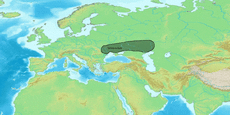Poltavka culture
| Part of a series on |
 |
|
|
Origins |
|
Archaeology Pontic Steppe East-Asia Eastern Europe Northern Europe Pontic Steppe Northern/Eastern Steppe Europe
South-Asia Steppe Europe Caucasus India |
|
Peoples and societies Indo-Aryans Iranians Europe East-Asia Europe Indo-Aryan Iranian |
|
|
| Bronze Age |
|---|
| ↑ Chalcolithic |
|
Near East (c. 3300–1200 BC) South Asia (c. 3000– 1200 BC) Europe (c. 3200–600 BC)
China (c. 2000–700 BC) |
| ↓Iron Age |
Poltavka culture, 2700—2100 BC, an early to middle Bronze Age archaeological culture of the middle Volga from about where the Don-Volga canal begins up to the Samara bend, with an easterly extension north of present Kazakhstan along the Samara River valley to somewhat west of Orenburg.
It is like the Catacomb culture preceded by the Yamna culture, while succeeded by the Sintashta culture. It seems to be seen as an early manifestation of the Srubna culture. There is evidence of influence from the Maykop culture to its south.
The only real things that distinguish it from the Yamna culture are changes in pottery and an increase in metal objects. Tumulus inhumations continue, but with less use of ochre.
It was preceded by the Yamna culture and succeeded by the Srubna and Sintashta culture. It is presumptively early Indo-Iranian (Proto-Indo-Iranian).
Sources
- J. P. Mallory, "Poltavka Culture", Encyclopedia of Indo-European Culture, Fitzroy Dearborn, 1997.